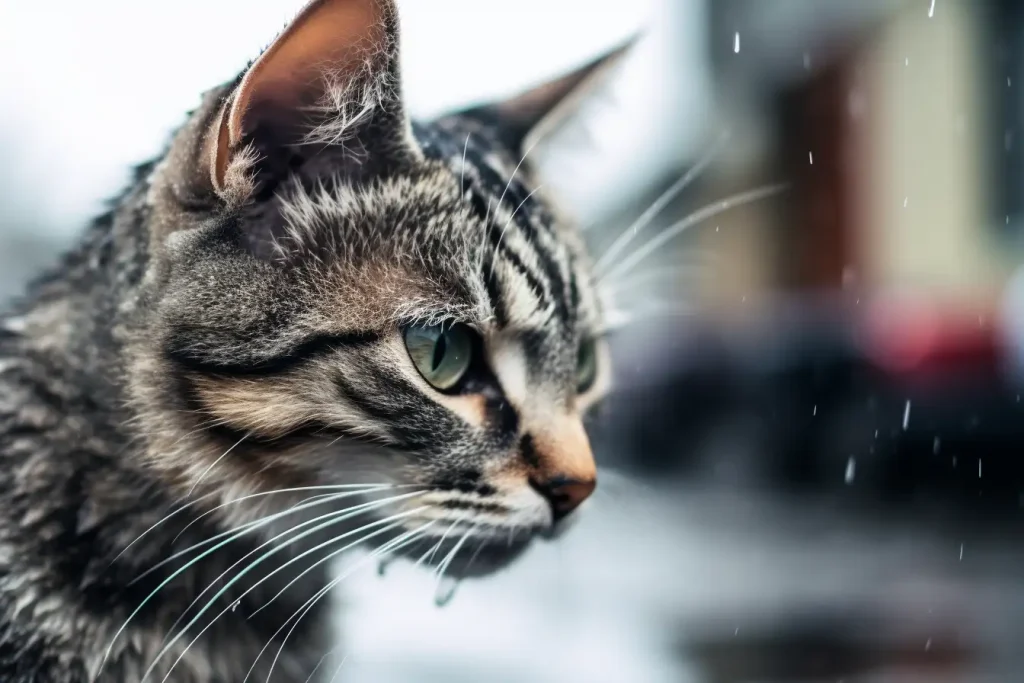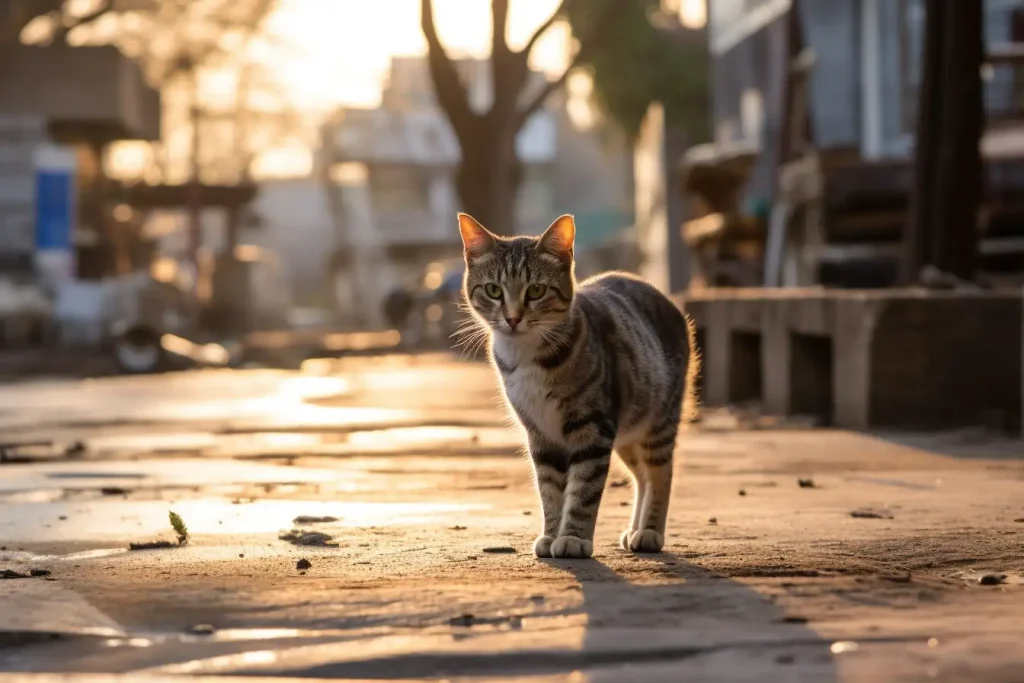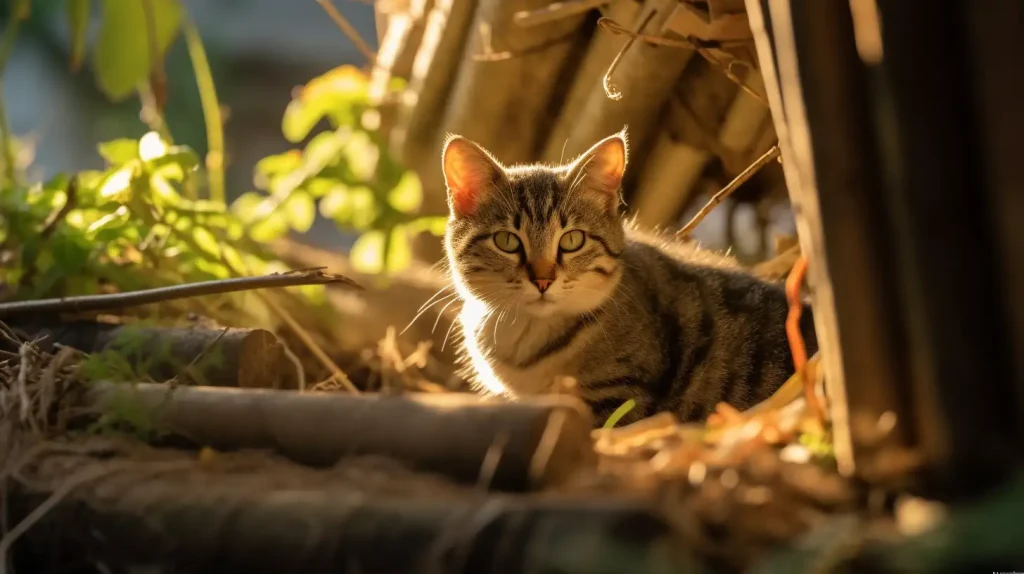Table of Contents
A stray cat keeps coming to your house likely because it finds something appealing or necessary for its survival, such as food, water, shelter, or a safe and quiet place to rest. Cats are opportunistic feeders and will return to places where they have previously found sustenance or comfort. Your house may offer the cat a sense of security or resources that it lacks elsewhere.
Let’s discuss this topic in more detail in the paragraphs below…
Whether you’re a dedicated cat lover or more of a casual admirer, you might find yourself wondering why a stray cat has taken a particular interest in your home. Understanding why this happens and knowing how to handle it can be important for both you and the cat in question.
Key Takeaways
- Why does a stray cat keep coming to my house? Well, understanding stray cats and their behavior is important for responsible handling and effective solutions.
- Assess if the visiting cat is a stray, lost pet, or feral cat before taking action.
- Gradual introduction to your home and existing pets is crucial for a smooth adjustment.
- Monitor the psychological impact of stray cats on house pets and consult a vet if needed.
- Consider participating in Trap-Neuter-Return programs to control the cat population humanely.
- Secure food sources, alter the outdoor environment, and use safe, humane deterrents to discourage stray cats.
- Carefully plan your outdoor space to maintain a peaceful environment while protecting feline visitors.
Understanding Stray Cats
Stray cats are cats that live most of their lives in the wild but have had some socialization, which means they’ve had some contact with humans. They differ from feral cats, which are totally wild and often resist human interaction. It’s also important to distinguish them from pet cats, which are fully domesticated and accustomed to living with people.
Stray cats often have unique patterns of behavior. They might be more elusive than pet cats, coming out mostly during the night and staying out of sight during the day. However, their previous socialization often means that they’re still open to human interaction, which can lead to them frequenting certain homes or neighborhoods.

Reasons Stray Cats May Visit Your Home
A variety of factors can contribute to a stray cat choosing your home as a frequent destination.
Food Availability
Cats are survivors, and a key part of survival is finding food. If there’s a consistent source of food around your home, it might be attracting stray cats. This could be an unintentional source of food, like a poorly sealed garbage bin or an outdoor compost pile. If you or your neighbors are intentionally feeding stray cats, they’ll also continue to visit in search of food.
Shelter
Next to food, shelter is another important factor for survival. Stray cats might find certain parts of your home or yard suitable for taking shelter, especially if there are spots that provide cover from weather or predators. The weather itself can also influence a stray cat’s need for shelter. During cold, rainy, or extremely hot weather, a stray cat might seek out a safe place to stay, like under a porch or in a garden shed.
Mating and Territory
Cats, like many animals, have instincts related to mating and territory. If you have other cats in your home—especially if they’re unspayed or unneutered—it might attract stray cats. Stray cats can also decide to make a particular area their territory if it provides a consistent source of food and shelter, leading them to return frequently.
Curiosity and Social Behavior
Cats are naturally curious creatures, and a stray cat might come to your house purely out of curiosity. If a stray cat has had positive interactions with humans in the past, it might also be more likely to approach homes in search of more positive interactions.
Scent Marking Behavior in Cats
One curious aspect of feline behavior that often intrigues, and at times frustrates, many of us is their propensity for scent marking. This practice is essentially a form of communication within the feline world. It’s like leaving a post-it note for other cats, saying, “Hey, this spot is mine.” When a cat rubs its cheeks or body against a surface, or sprays urine, it’s leaving behind its unique scent profile. This acts as a marker, helping them establish and maintain territories, and convey other messages to fellow felines in the area.
So, if you’ve noticed a stray cat continually returning to your house despite efforts to dissuade it, scent marking may be the culprit. The stray may have marked certain parts of your property as part of its territory. This olfactory footprint reassures the cat whenever it returns, reinforcing the idea that it’s in a familiar and claimed area. Cleaning these areas thoroughly, with products designed to eliminate pet odors, may help disrupt this behavior and make your house less attractive to the stray. Understanding this aspect of cat behavior is key to creating a cat deterrent strategy that is effective, and sensitive to the instincts of these fascinating creatures.
How to Handle Stray Cats Visiting Your Home
If a stray cat is regularly visiting your home, there are several steps you can take to handle the situation responsibly.
Assessing the Situation
First, it’s important to assess the situation. Is the cat truly a stray, or could it be a lost pet or a feral cat? A cat that’s approachable and doesn’t shy away from humans might be a stray or lost pet, while a cat that seems fearful or aggressive could be feral.
The Importance of Not Immediately Feeding Stray Cats
It can be tempting to feed a stray cat that comes to your home, but it’s important to resist this urge. Feeding a stray cat can encourage it to return and can contribute to issues like overpopulation if the cat isn’t neutered or spayed.
Contacting Local Animal Welfare Organizations
Your local animal welfare organizations can provide assistance if a stray cat is frequently visiting your home. They might be able to provide advice, resources, or even assist with trapping the cat and ensuring it receives necessary care.
Trapping a Stray Cat Safely and Humanely
If you decide to trap a stray cat, it’s crucial to do so safely and humanely. This often involves using a specific type of trap designed for cats, baiting it with food, and ensuring the cat isn’t harmed during the trapping process.
Fostering and Adoption Considerations
If you’ve fallen for a stray cat that’s been visiting your home, you might be considering adoption. It’s important to remember that stray cats may require additional socialization and care, but with patience and compassion, they can often make loving pets.
Preparing for Adoption
Before you officially welcome a stray cat into your home, make sure that you’re prepared. This involves not just making sure your home is cat-proof, but also ensuring you have the necessary supplies such as food, a litter box, a scratching post, and a comfortable bed for the new arrival. If the cat has health issues, be ready for potential veterinary expenses as well.
Introducing the Stray Cat to Your Home
Once you bring the stray cat into your home, give it its own space initially. This could be a spare room where the cat can adjust to its new environment. Spend time with the cat in this space, allowing it to get used to your presence and scent.
Introduction to Other Pets
Introducing a stray cat to existing pets should be a gradual process. Start by allowing them to sniff each other’s scent. This can be done by swapping bedding between the new cat and existing pets, or rubbing a cloth on one animal and placing it near the other.
Once they are familiar with each other’s scent, the next step is visual contact. This can be facilitated by a baby gate or a cracked door.
The final step is a face-to-face meeting. During this process, it’s important to supervise and keep interactions short to prevent any potential conflicts. Over time, these sessions can become longer as your pets become accustomed to one another.
Monitor Their Interactions
Even after successful introductions, keep an eye on the animals when they are together. Look out for signs of aggression or fear. If these signs appear, go back to the step where your pets were comfortable and proceed more slowly.
Remember, every cat is unique, so the time it takes to adjust will vary. Patience, understanding, and positive reinforcement will go a long way in creating a harmonious multi-pet household.

The Psychological Impact of Stray Cats on House Pets
Impact on Social Behavior
If you’re noticing changes in your household pet’s behavior, the stray cat’s visits might be to blame. When a new cat enters their territory, pets may feel threatened. This can cause them to display signs of stress, such as hiding, excessive grooming, or becoming more vocal. Pets might also exhibit changes in social behavior, showing signs of aggression or, conversely, becoming unusually withdrawn. It’s important to monitor your pet for any drastic changes and consult a vet if these persist.
Impact on Feeding and Resting Patterns
Another area of potential impact is your pet’s eating and sleeping patterns. The presence of a stray cat might cause disruptions leading to irregular feeding and rest. This could be due to stress or the interruption of their usual routine. If your pet is refusing food or seems to be sleeping more or less than usual, it could be a sign that the stray’s presence is causing distress.
Indications of Marking Territory
When another cat intrudes into their territory, house pets may respond by marking their territory more aggressively. This is particularly common among unneutered males but can occur with any cat feeling threatened. Marking behaviors might include spraying, scratching furniture more than usual, or even leaving their feces uncovered as a sign to the intruder.
The introduction of a stray cat into a household pet’s territory can significantly impact their wellbeing. By understanding these potential changes, you can better support your pet and manage the interaction between them and the stray visitors. Remember, if you notice any severe changes or if symptoms persist, it’s always a good idea to consult with a veterinarian.
Health Risks to Humans and Pets
While the sight of a stray cat frequenting your property may evoke feelings of compassion, it’s crucial to acknowledge that these felines can sometimes pose health risks to both humans and pets. Stray cats may carry diseases or parasites, some of which can be transmitted to other animals or even people.
Zoonotic Diseases
Zoonotic diseases, or diseases that can be passed from animals to humans, are a potential concern with stray cats. One such disease is Toxoplasmosis, a parasitic infection that cats can contract from infected rodents or birds. While many infected people often have no symptoms, Toxoplasmosis can cause serious health issues in pregnant women and individuals with weakened immune systems.
Rabies
Rabies is another zoonotic disease, although it’s less common in cats than in wild animals like bats or raccoons. Nevertheless, a stray cat with unknown vaccination history could potentially be a carrier. Rabies is fatal once symptoms appear, making prevention—through avoiding unnecessary contact and keeping your own pets vaccinated—critical.
Parasites
Stray cats can carry external parasites like fleas and ticks, which can easily infest your yard, home, or other pets. These parasites can carry diseases themselves. For example, ticks can spread Lyme disease, and fleas are known carriers of the plague.
Risk to Pets
In addition to parasites, stray cats can transmit illnesses to pet cats, including FIV and FeLV (discussed above). Both of these diseases are serious and can compromise a cat’s immune system, leading to other secondary infections.
Knowing these risks underlines the importance of treating stray cats with caution. Helping strays is commendable, but it should be done responsibly, with the wellbeing of all parties in mind.

The Role of Trap-Neuter-Return (TNR) Programs
Trap-Neuter-Return, or TNR, programs play an essential role in managing stray cat populations. These programs involve trapping stray cats, having them neutered or spayed to prevent reproduction, and then returning them to their territory. TNR programs help to control the cat population in a humane way, preventing the issues associated with overpopulation while allowing cats to live out their lives in the wild.
Ways to Discourage Stray Cats from Coming to Your House
If you’d prefer that stray cats stop visiting your home, there are several steps you can take to discourage them.
Securing Food Sources
First and foremost, ensure all potential food sources are secured. This can mean sealing your garbage bins, avoiding leaving pet food outside, and asking your neighbors to do the same.
Altering the Outdoor Environment
You can also make your yard less appealing to stray cats by removing potential shelter spots and avoiding things like bird feeders that can attract cats.
Creating a Cat-Proof Outdoor Space
Creating a cat-proof outdoor space might sound like a tall order, but it can actually be quite doable with a few thoughtful considerations. Remember, the aim here is not to create an impenetrable fortress, but rather to discourage stray cats from entering your space while ensuring their safety.
When it comes to landscaping, your choice of plants can make a difference. Cats dislike certain types of plants like rosemary, lavender, or rue, due to their strong scent. Incorporating such plants into your garden could act as a natural deterrent. Additionally, the texture of your ground cover can also influence a cat’s desire to enter your yard. Cats generally don’t like walking on sharp or prickly surfaces. Mulching your garden with materials like pine cones, holly cuttings, or stone chips can help deter cats from walking through your yard.
Consider your fence as well. A good cat-proof fence doesn’t necessarily need to be extremely high, but having a design that leans outward or uses roller bars at the top can discourage agile cats from climbing over it. Remember, the goal isn’t to trap a cat inside your yard, but to discourage them from entering in the first place. A carefully planned outdoor space can ensure you maintain a peaceful environment while also protecting the well-being of your feline visitors.
Use of Safe and Humane Cat Deterrents
There are also several safe and humane cat deterrents available, from sprays with scents that cats dislike to motion-activated sprinklers. Using these deterrents can help keep stray cats away from your home without causing them harm.
Ensuring Your Pet Cats Are Spayed or Neutered
If you have pet cats, ensuring they are spayed or neutered can prevent them from attracting stray cats.
Why Does a Stray Cat Keep Coming to My House – Conclusion
Understanding why stray cats keep coming to your house is crucial for responsible handling. Their previous socialization, curiosity, mating instincts, and the availability of food and shelter can all contribute to their frequent visits. By implementing appropriate measures, such as spaying/neutering, providing consistent food sources without encouraging dependence, and practicing responsible socialization, you can ensure the welfare of both the stray cats and your household. Remember, each cat is unique, so patience and gradual adjustments are key as you navigate this situation compassionately.



